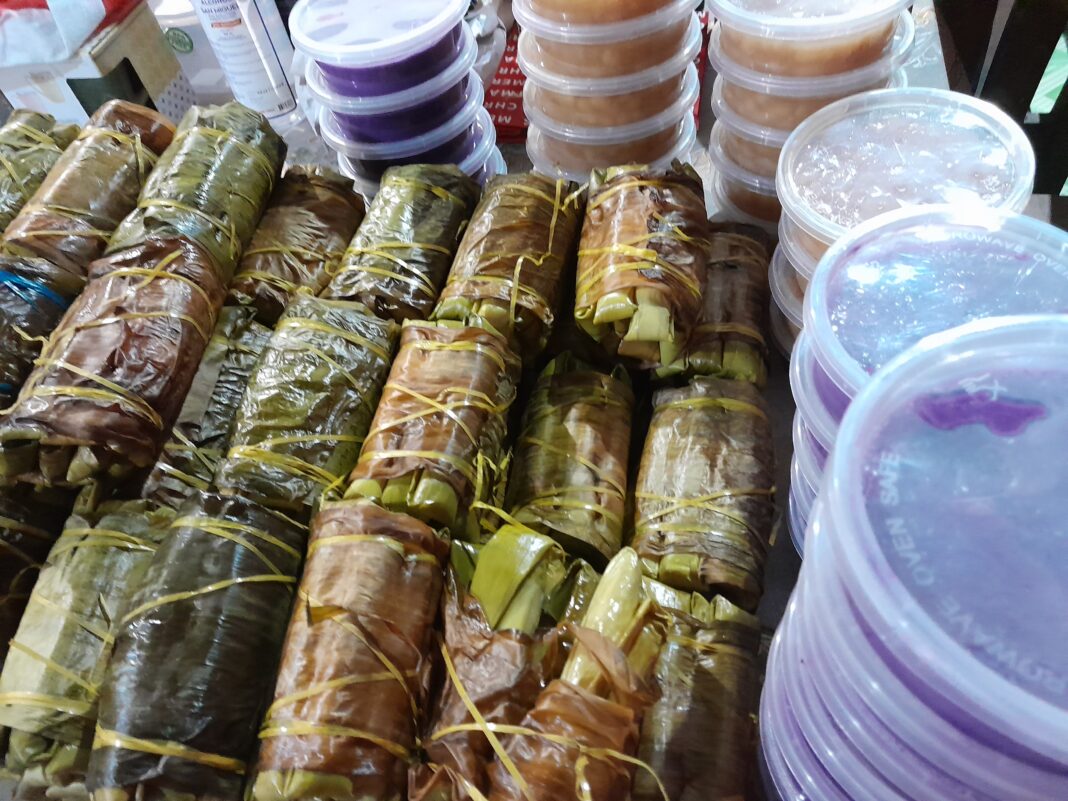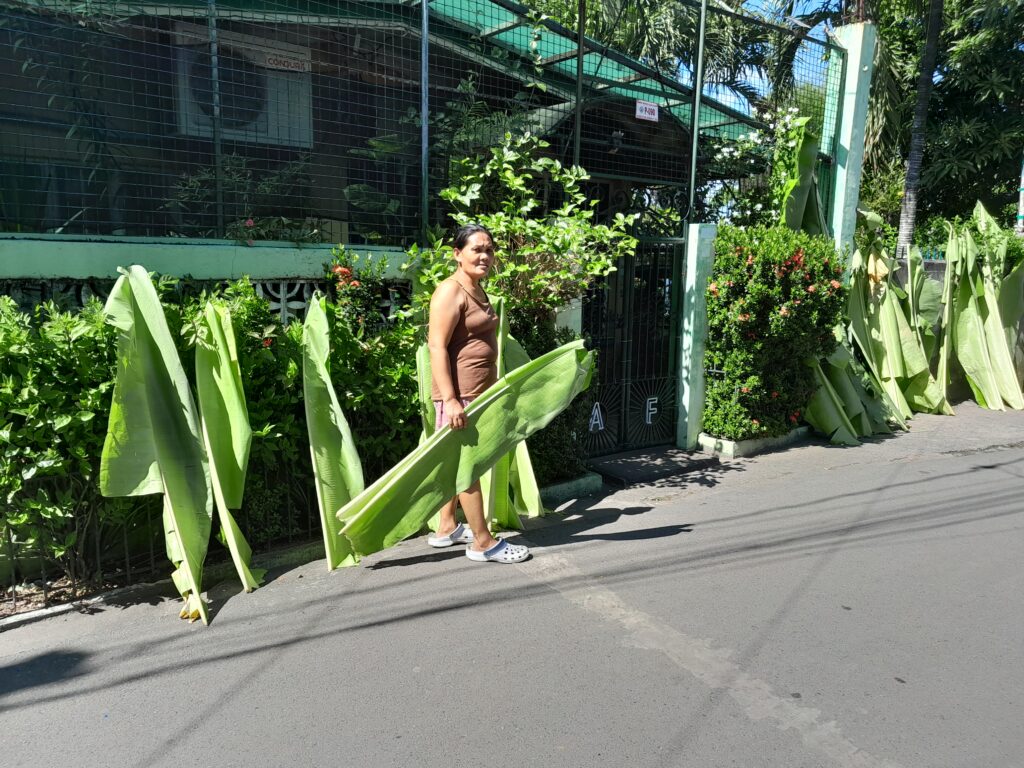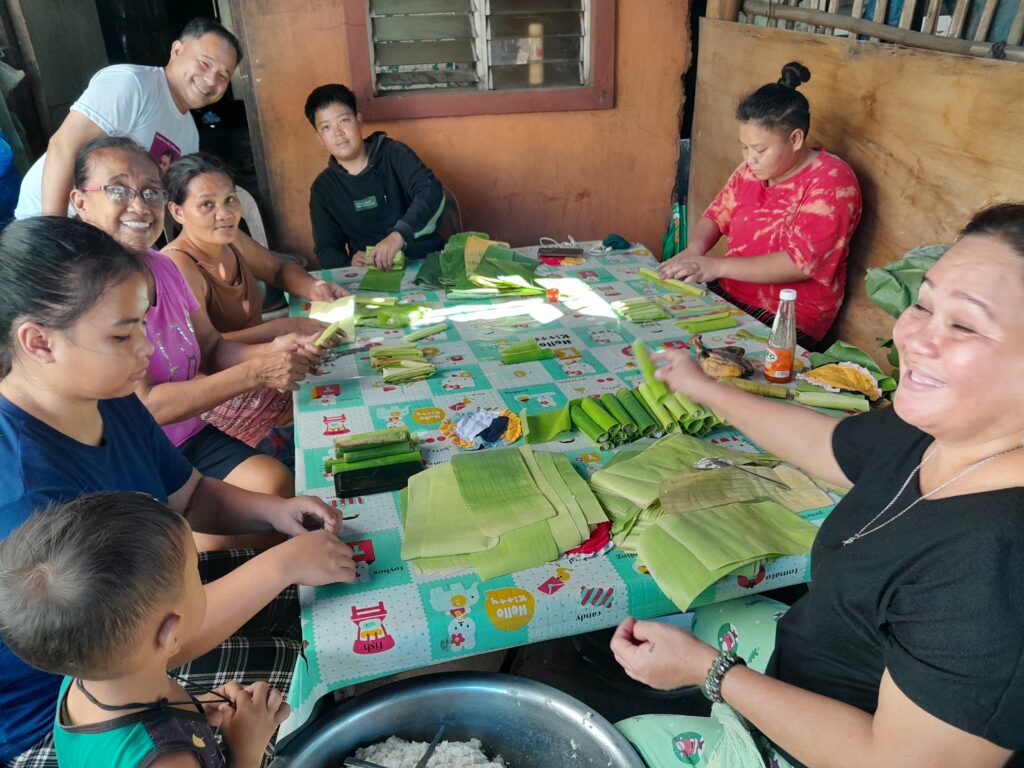
BULAKAN, Bulacan—From only one maker of Christmas Season sweet delicacy “Suman Pasko” (rice cake wrapped in banana leaf and sold in bundles of ten or bugkos) “ube halaya” (purple yam) and “minatamis na beans” (sweetened beans) in Barangay Maysantol this town, there are now three to meet the demands for Dec. 31 Buena Noche and the Jan. 1 feast.
Puriing Paraiso, 73 and Elena Cruz, 65 are now also rushing bulk of orders of suman, ube and beans to meet the demands from their own buyers and from their neighbor Rosalie “Beng” Godoy, 44, the most known suman maker in their place in Paliwas street.
Bulk of orders from their neighbors, adjacent Barangay Tibig, Barangay San Jose, Sta. Ana, Balubad and from Balagtas and Guiguinto towns including from City of Malolos continuous.

Godoy who has been making suman, ube halaya and beans for twenty three years now expressed elation that the rice cake wrapped in banana leaf still makes waves these days despite the now pricey amount.
From the regular P40 to P50 this Holiday Season to P60-P90.00 of each bundle or bugkos, her suman still move fast, said Godoy.
During the early years of making and selling suman, the glutinous rice only costs P17.00 per kilo and each bugkos of suman was only worth P20.00. In the succeeding years, it increased with at least P5.00 every after five or seven years—P25.00-P30.00-P35.00. Today, at P68-70 per kilo of the glutinous rice, a bugkos costs P40-P50.00 each on regular days but the demand this Holiday Season caused them to increase each bundle up to P60-P90 to meet the payment for additional helpers.
Other than the glutinous rice, suman also uses coconut milk and salt and wrapped in “tunod” (young banana leaves). Banana leaves are bought from P3.00-P5.00 each. Each piece of suman are wrapped in banana leaf and are gathered in a bundle of 10 pieces, warpped again in banana leaf before being boiled to cook.
Godoy said her gross sales for this Holiday Season could reach more than P150,000 compare with around P60,000 in the previous years including during the pandemic.
Cruz who is also a known suman maker has to make double time efforts now due to numerous orders from other barangays. She estimates her gross sales to reach up to P50,000.
“We know Beng cannot meet all the orders and because our family also used to make suman, we are taking the opportunity to also earn,” she said.
Paraiso said orders also came to their doorstep. “These are spill overs of orders to Beng which she can no longer afford to make,” she said. She said she could sell up to P20-P30,000 worth.
It has long been a tradition in Bulacan to serve Suman Pasko, ube halaya and beans during Noche Buena, the Christmas day itself, Buena Noche and on Jan. 1 as distinct Christmas foods. The rice cake in banana leaf known as “suman yangit” in other places in the country became famous in Bulacan as “Suman Pasko” because of the long tradition that they are served with halaya and beans during Christmas Season.

“There are many families and homes which make suman, halaya ube and beans their special food during Noche Buena and during the whole day of the Christmas Day and on Buena Noche and New YEar’s Day. There are homes which only has ordinary daily menu and do not prepare a lavish Holiday meals except for these sweets. They are what they serve to guests. (Marami kasing pamilya at mga bahay-bahay, ang suman, beans at ube halaya ang major na handa nila kapag Pasko at kahit simpleng ulam lang basta iyan ang special nilang handa, kasi iyan ang pang-Pasko lang na talaga na handa. Iyan din ang pinapakain nila sa bisita), she told NEWS CORE.
Way back in the 1980’s and even until now, Joey Meneses Rodrigo, former Tourism and Information officer of Bulakan municipal government and now vice president of Kabesera Inc, a heritage and cultural group of Bulakan who is also from Maysantol, recalls the suman, ube and beans Christmas delicacy as a product of a “community bayanihan” in their place.
A group of two-three elderly housewives would go one house to the other 2-3 days before the Noche Buena or the Christmas Day itself and ask for contributions for the ingredients. For the rice cake, it can be in kind for the banana leaves (tunod), coconut (coconut milk or gata) which are available in the backyard including rice and the glutinous rice and cash money for the ube and beans. After they were cooked, they will be distributed for free to each of the contributors.
“It is a bayanihan community. Kinalakihan ko, may 2 o 3 matatandang babae ang nagbabahay-bahay babae 2-3 araw bago ang Pasko ang nangangalap ng dahon ng saging, lalo na un tunod (young banana leaves) at niyog na karaniwan na galing lang sa kani-kanilang mga bakuran at pag nakalap na, gagawin ng suman, sa dami ng suman, paghahatian iyon ng community. Bibigyan ang nagbigay ng mga ingredients,” Rodrigo told NEWS CORE.
In those times, people in the community have time to stage that bayanihan, he said.
According to Rodrigo, the suman and the halaya and beans are the stars of Christmas especially for those who cannot afford to prepare morcon, hamonado, embutido, relleno and other special occasion menus.”
“Para sa may mga kaya, ang Noche Buena ang morcon, embutido, hamonado, relleno, pero para maraming pamilya, sapat na ang suman,” he said.
The suman is just made of rice, coconut milk and salt which are ordinary ingredients and it is made special during Christmas because of the ube and beans. Rodrigo said, because of these, Bulakenyos called it as “Suman Pasko”. During ordinary days in the year, the suman can only be matched with plain sugar as sauce.
“Bigas, gata at asin lang nama ang mga preparasyon at saka dahon ng saging na tunod, pang mahirap lang. Simple at afford. Simple pero special dish na ng marami kaya ito ang tinatawag nating Sumang Pasko kapag katerno at sinasawsaw na sa ube halaya at beans. Pag di panahon ng Pasko pwede na ang asukal lang ang sawsawan”.
“Ordinary folks may not be able to afford to give away morcon, lechon, hamonado or embutido pero they can donate or give away sumang Pasko. This way Bulakenyos express the spirit of giving during Christmas,” Rodrigo said.
Until today, the spirit of bayanihan of the people of Barangay Maysantol continue to live on especially during Christmas, Rodrigo said because its residents continue to order for suman, ube and beans not only for their families but as special gifts for their families living in Metro Manila, other parts of Bulacan and Luzon.
“Hanggang ngayon uso pa rin ang bigayan ng suman tuwing pasko sa Bulakan. Nawala man yung culture na the community is involved in the preparation, pero umoorder ng maraming (bugkos ng suman) bundle kadalasan ang pamilya. For example oorder si misis ng 10 bundles, 2 lang dito ang kakainin nila. Yung natitirang 8 ay ipangreregalo sa pamilya ng kaibigan, kapamilya o kapitbahay,’ Rodrigo said.
“It is a Christmas family tradition and it never stopped even our folks were already gone. We and our children have kept these Christmas deserts in our Noche Buena and Buena Noche. Not a year that passed without these sweets in our homes during Christmas,” Theresa Reyes-Eleogo, 63, a neighbor regular buyer of the sweet delicacies.
Jose Benigno Corpuz, Bahay Makabayan mini museum owner in Marilao town, book author and a culture and heritage icon in the province said the suman is the Filipinized or the country’s own version of what Chinese and Spaniards have influence our cuisine.
However, even before they came, our country has its own regional crops, fruits which are made into these special deserts and sweets. That’s why the delicacy deserts have different versions in the different provinces and regions. He said what is abundant of these crops and fruits in one particular locality create one distinct version different from the others.
The food being sticky and sweet is associated with the value and love of the Filipino people to each and every member of the family especially in celebrating the Christmas and New Year. “These have been our culture as Filipinos, as we celebrate Christmas, the most awaited and joyous occasion of the year. It is a family affair and these foods represent our closeness, our special bonds as kin,” he said.






